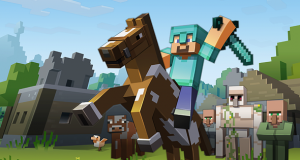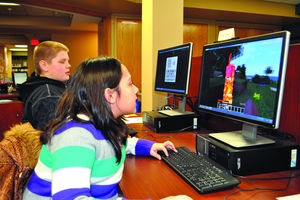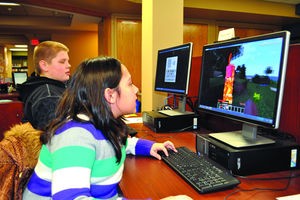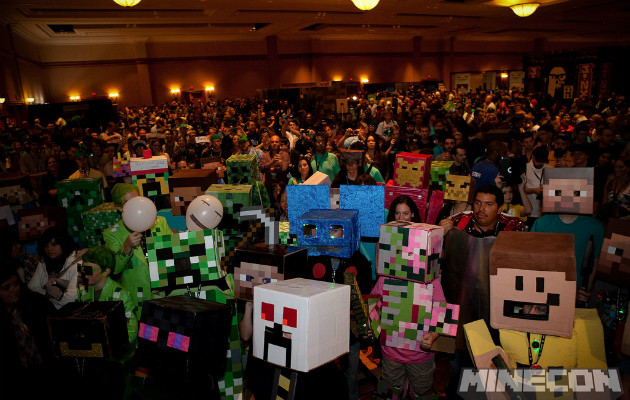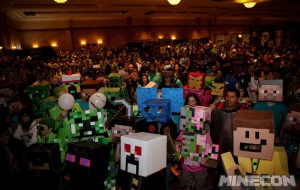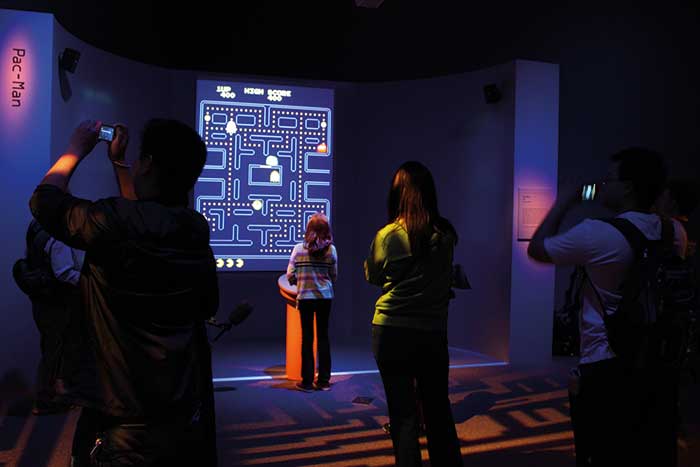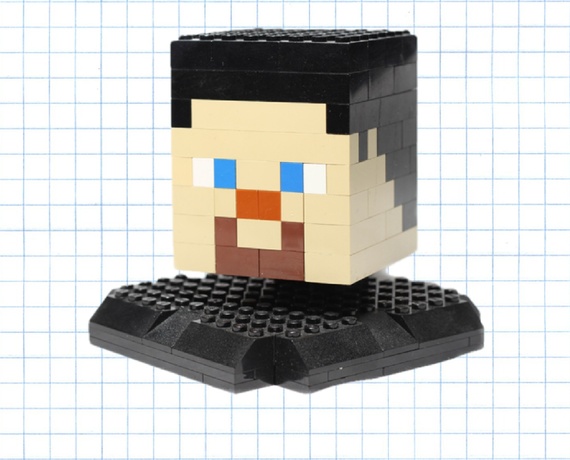
Like many 11-year-olds in Texas, Ethan had to build a model of the Alamo as a school project. Often, students make their dioramas out of paper mache or popsicle sticks, but Ethan’s teacher gave him permission to build his project in Minecraft, the popular sandbox software game in which players build structures out of blocks. With his dad’s help, Ethan recorded a video tour of his scale model of the fort, complete with explanatory signs, and posted it on YouTube. A few minutes into the tour, it started raining unexpectedly over Ethan’s diorama, but Ethan noted, “This is exactly what happened during the battle of the Alamo—it rained.” To his dad—and, presumably, his teacher—this comment revealed Ethan’s familiarity and knowledge with the subject matter that he might not have had otherwise shown.
With more than 18 million downloads to date, Minecraft is the best-selling computer game of all time; the game’s free-form structure has made it popular with kids and adults alike. But little by little, teachers, parents, and students have discovered that the game can be used for educational purposes, too. Former teacher Joel Levin and his colleagues founded a startup called TeacherGaming that aims to bring Minecraft into classrooms everywhere, helping students and teachers of all disciplines use their creativity to design projects, free from the kinds of limitations they would face using traditional methods.
“Teachers already want to use these games in the classrooms,” Levin said. He and his colleagues work to make the software more intuitive and suited to their needs so that teachers—and students—can use the games in classrooms and have fun while they’re at it.
Levin, now 40 with a sandy beard, glasses, and ponytail, first played an early version of Minecraft with his 5-year-old daughter in 2010. He was amazed at how much his daughter was learning from Minecraft; she solved problems on her own, developed a spatial understanding in the game, and accelerated her reading and writing skills because she wanted to be able to interact with other players, he said. At the time, Levin was teaching technology classes at a private elementary school in New York City, so he decided to try out some Minecraft lessons with his second graders. As a self-identified “gamer” who worked with an Internet service provider before the dot-com bubble burst, Levin saw that teaching with Minecraft combined his interests perfectly.
The segment that involved Minecraft was intended to last a week, but Levin used the game for the rest of the semester, teaching students to type by allowing them to communicate with each other in the game and showing them how to do online research by trawling the vast Minecraft forums for specific information. But getting there wasn’t easy; Levin spent a lot of time customizing the game to fit his instructional needs. Minecraft is an open-ended game with a never-ending landscape and digitally rendered resources. In certain game modes, players have to gather resources to craft shelter, tools, and armor to meet basic needs and survive battles with one another. But the part that players seem to enjoy the most is the construction element, in which they build entities like functional computers or reconstruct landscapes such as the entire country of Denmark. Given how versatile the game is, it’s understandable that Levin wanted to restrict some of these capabilities to give his students a safe, age-appropriate experience. He modified the code so that kids weren’t able to fight with one another in the game, and he limited some of their geographic range so that they could find their way back to a central location where they had a building just for their class to use. He wasn’t yet plugged into the online community where teachers were sharing similar modifications to the game, so he coded it all himself.
But it was worth it. Levin’s students learned more than just the hard skills he had intended for them to they pick up—they were also having profound discussions about topics that were notoriously challenging for teachers to communicate effectively. “It led to conversations in the classroom about how we treat these virtual spaces that we all find ourselves in, especially the young people that are coming into this complicated world of social networking,” Levin said. “Are we going to treat our class’ Minecraft world as an extension of our classroom? Do the rules that apply in the school building also apply on our Minecraft server? What happens if someone breaks those rules?” These were lessons in what Levin calls digital citizenship, which were typically being taught in middle school, once students were already deeply embedded in social networks, but not yet in elementary school when they were just starting to use them and the lessons would be most useful. “There was just so much to do and the game was so malleable that I kept being able to bring in all the things I needed to teach in the game,” Levin said. He started a blog to share his experiences with other teachers, and it went viral, making its way to the front page of Reddit.
Though he had heard of game-based learning and knew he was “kind of doing it,” Levin was unfamiliar with the research emphasizing the educational value of some video games. Studies published over the past two decades support the idea that video games can increase students’ spatial knowledge, improving their aptitude for math and science. And video games can help give students the hard skills they will need to function in a digital world, such as physical dexterity with keyboards and touch screens, an understanding of algorithms and search engines, and even basic programming. “Games are also uniquely suited to fostering the skills necessary for navigating a complex, interconnected, rapidly changing 21st century,” Alan Gershenfeld, the president of videogame publisher E-Line Media, told Scientific American.
Levin knew that he had stumbled onto something great by bringing Minecraft into the classroom, so when Finnish educator and gamer Santeri Koivisto found his blog and approached him about founding a company to make a version of Minecraft for educators, he couldn’t say no.
Three years since its inception, TeacherGaming now has nine employees that have worked to create MinecraftEdu, which has been sold to schools in 42 countries and six continents. TeacherGaming licenses Minecraft from Mojang, the small Swedish company that created the game and is now owned by Microsoft, and sells the educational version that incorporates many of Levin’s original modifications. MinecraftEdu also has some new elements based on teacher feedback and beta testing, like the ability to freeze students mid-play.
But Levin and his colleagues knew that, for MinecraftEdu to make its way across the curriculum, they had to lower the technological barriers, replacing complex code with intuitive check boxes or in-game tools designed for teachers to use even if they’re not hardcore programmers. Levin noted that TeacherGaming sells about half its software to technology classrooms, but the other half is evenly distributed across other subjects.
This is where Levin has seen incredible displays of teachers’ own creativity, especially from those who try to use MinecraftEdu to fulfill Common Core standards, the universal math and reading benchmarks for students at each grade level. Though MinecraftEdu is a great tool, Levin admits that the game doesn’t perfectly align with many of these standards, so innovative teachers have developed new ways of using the software to satisfying the requirements. “TeacherGaming does have curriculum, we have Minecraft ‘worlds’ that you can download and use in your own classroom, but teachers didn’t want to download what we were making—they wanted to make their own experiences,” Levin said. History teachers make Minecraft dioramas, English teachers have kids act out Shakespeare plays in a model of the Globe Theater, and art teachers let students recreate famous works of art in the game. Now, Levin says that teachers have created 98 percent of the downloadable “worlds” in the MinecraftEdu forum.
Most of the teachers that I spoke to are part of a Google group for educators using MinecraftEdu and were unanimously enthusiastic about what they had been able to accomplish with students using the software. Sara Richards, an instructional technology specialist in Round Rock, Texas, began her interest in the game after talking with a parent about how to help a student with some learning disabilities. “We thought it would be fantastic if we could harness the excitement of Minecraft into an educational setting, especially to help bolster children who might not always be successful in a traditional school setting,” Richards said. In the 13 months since then, Richards has seen second graders build elaborate digital communities, helped students recreate a scene from A Cricket In Times Square, and watched third graders quickly grasp the mathematical concepts of area, perimeter, and volume.
Diane Main teaches a high-school computer-science class at the Harker School in San Jose, California. She has been using MinecraftEdu with her students for the past two years and has been consistently impressed by what her students have created in the game, especially when they are given the flexibility to follow their own interests, figuring out how to do the desired actions in their own way. “When you have opportunities for creativity and more open-ended situations, it allows kids to figure out that they can try things, they can do things differently—there’s not one formulaic way to do well in this class,” Main said. “A student told me after the class that he learned that first option [to solving a problem] isn’t always the best option. And that’s something you can’t teach kids—they need to have the opportunity to experience it themselves.”
In the past year TeacherGaming has expanded to include another game called Kerbal, which is more focused on math and engineering than Minecraft is. As TeacherGaming makes educational versions of more games, its founders hope to continue to give teachers the creativity and ability to present their students with new challenges. “I’m really proud that we’ve been able to be a vehicle for experimentation in different types of progressive education,” Levin said.

